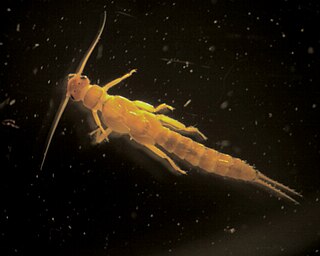
Plecoptera is an order of insects, commonly known as stoneflies. Some 3,500 species are described worldwide, with new species still being discovered. Stoneflies are found worldwide, except Antarctica. Stoneflies are believed to be one of the most primitive groups of Neoptera, with close relatives identified from the Carboniferous and Lower Permian geological periods, while true stoneflies are known from fossils only a bit younger. Their modern diversity, however, apparently is of Mesozoic origin.

Taeniopterygidae are a family of stone flies with about 110 described extant species. They are commonly called willowflies or winter stoneflies and have a holarctic distribution. Adults are usually smaller than 15 mm.

The Capniidae, the small winter stoneflies, are a family of insects in the stonefly order (Plecoptera). It constitutes one of the largest stonefly families, containing some 300 species distributed throughout the holarctic. Their closest relatives are the rolled-winged stoneflies (Leuctridae).

Chloroperlidae are a family of stoneflies, commonly known as green stoneflies, with more than 200 species and 22 genera. They appear green to yellow in colour, and are popularly used among fisherman as bait for trout fishing. Green stoneflies live in the benthic zone of the cold streams and rivers of five continents and four zoogeographical regions, emerging from the water to live in the riparian zone as adults. They are sensitive to pollutants, making them an indicator species for determining the quality of water bodies. Chloroperlidae are hemimetabolous, having no pupal stage, but instead hatch from eggs as nymphs and mature directly into adults. They are omnivorous, feeding on small organisms and plant particles, and become more carnivorous as they mature. The classification of Chloroperlidae is contested, with some believing that they should be considered as members of different orders, as opposed to the order Plecoptera that they currently belong to.

Dinocras ferreri is a species of stonefly belonging to the family Perlidae.
Zapada is a genus of spring stoneflies in the family Nemouridae. There are at least 10 described species in Zapada.

Perlodinae is a subfamily of springflies in the family Perlodidae. There are at least 20 genera and 60 described species in Perlodinae.

Paragnetina is a genus of common stoneflies in the family Perlidae. There are at least 20 described species in Paragnetina.

Acroneuriinae is a subfamily of common stoneflies in the family Perlidae. There are about 32 genera and about 520 described species in Acroneuriinae.
Ostrocerca is a genus of spring stoneflies in the family Nemouridae. There are about six described species in Ostrocerca.

Acroneuria is a genus of common stoneflies in the family Perlidae. There are more than 30 described species in Acroneuria.

Sweltsa is a genus of green stoneflies in the family Chloroperlidae. There are more than 50 described species in Sweltsa.
Paraperla is a genus of green stoneflies in the family Chloroperlidae. There are at least two described species in Paraperla.
Utaperla is a genus of green stoneflies in the family Chloroperlidae. There are at least four described species in Utaperla.
Doroneuria is a genus of common stoneflies in the family Perlidae. There are at least two described species in Doroneuria.

Perla is a genus of common stoneflies in the family Perlidae. There are at least 30 described species in Perla.
Notonemouridae is a family of stoneflies in the order Plecoptera. There are more than 20 genera and at least 120 described species in Notonemouridae.
Styloperlidae is a family of stoneflies in the order Plecoptera. There are at least 2 genera and 9 described species in Styloperlidae. The species etymology is based on the type locality near Sapa.
Neaviperla is a genus of green stoneflies in the family Chloroperlidae. There is one described species in Neaviperla, N. forcipata, found in North America. The species was formerly called Suwallia forcipata.

Siphonoperla torrentium is a species of stoneflies in the family Chloroperlidae.











